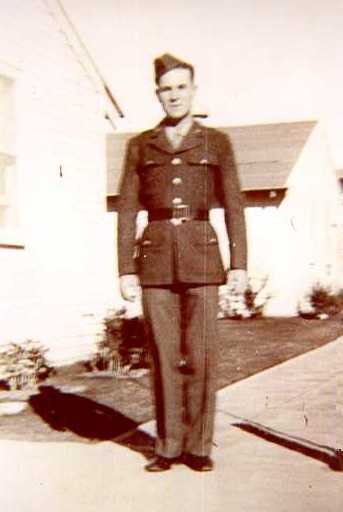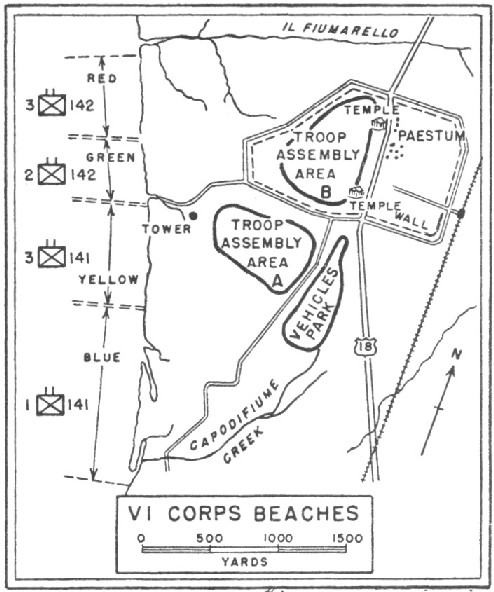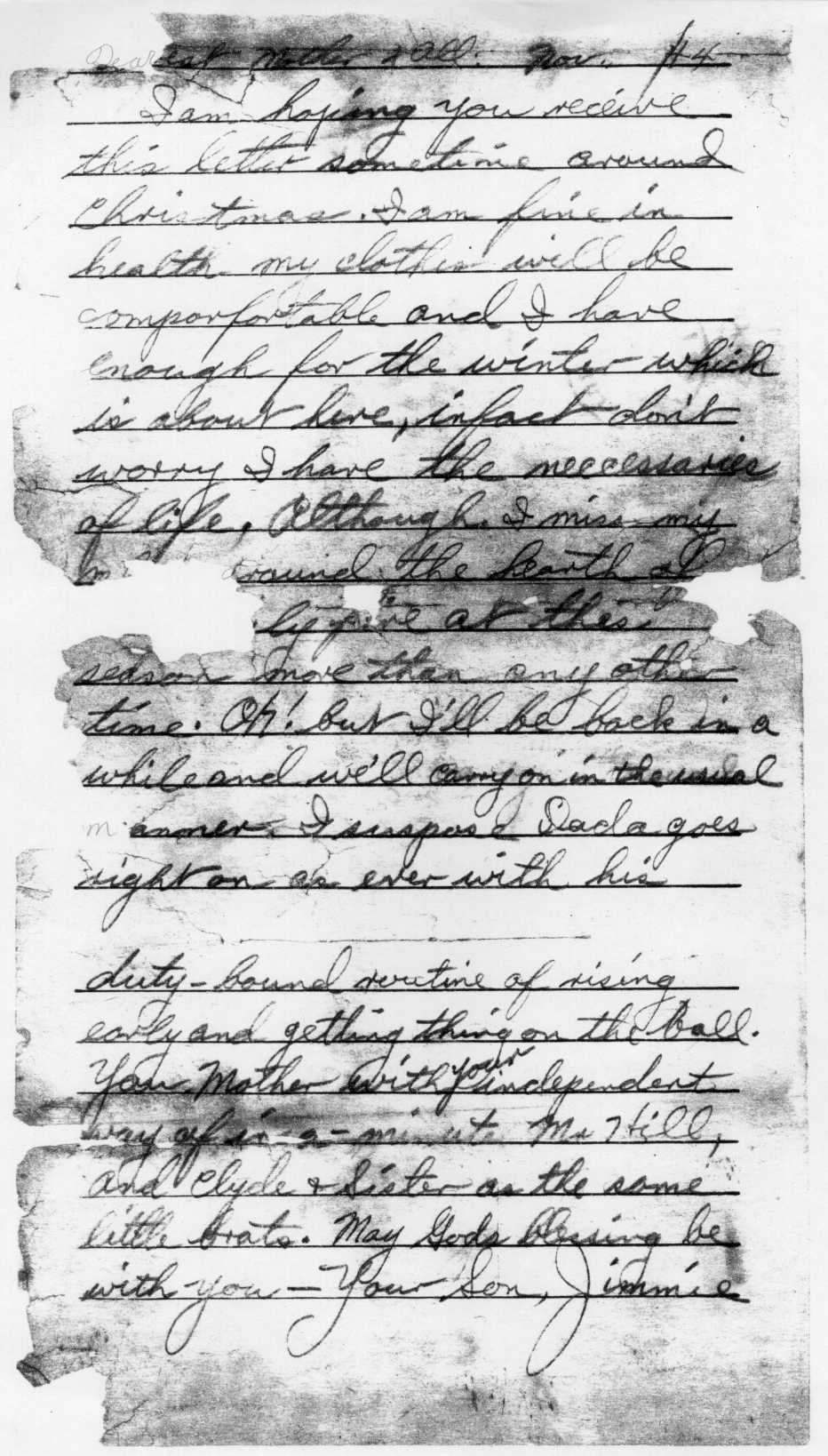
Private
Jimmy
S. Hill, Jr.
Company L, 142nd
Infantry Regiment,
36th
Texas Infantry Division
| MENU SELECTION: | The Italian Campaign | At The Front | Books | Armies | Maps | 85th Division | GI Biographies | Websites |

Private
Jimmy
S. Hill, Jr.
Company L, 142nd
Infantry Regiment,
36th
Texas Infantry Division
Jimmy Hill is my Uncle who was a member of the 36th Texas Division and his company was one of the first American units to land on Italian mainland. Whenever I asked what regiment he was in, he only said he was moved around between units during training. I've recently made contact was a member of his squad, Orby Ledbetter. Mr. Ledbetter has been able to fill in some of the missing bits of information about the day they were captured at Salerno. Mr. Ledbetter has identified their unit as of 3rd Platoon of Company L, 142nd Infantry Regiment.
Update: Jimmy Hill died on May 6, 2005.
DUI Pin for 142nd Regiment
Before the war
Jimmy lived in a rural town in Mississippi with his 2 brothers and 1 sister(my Mother). Jimmy was the shortest of the family but he was the toughest. He played football and sports and worked hard around the farm. This did result in a bad knee that Jimmy could "throw out" of joint when he wanted to impress the girls.
Jimmy joined the Army and trained at Fort Dix, NJ. He excelled in training as can be seen by his marksmenship medals, below. Then he was transferred into the 36th "Texas" Infantry Division just before they departed for overseas. He was a member of Company L, 142nd Infantry Regiment. In later years, I tried to ask my Uncle Jimmy about his time in the Army. He answer was always that he forgot. Later, I located someone in his unit who told me about their time in combat during the amphibious landing at Salerno, Italy. This is a description of the Salerno landings.
The Hill Family before the War
A group photo of the entire family during happier times. Jimmy is on the right, standing next to his oldest brother, Joel. My Mom, Lillibeth, is seated next to the youngest, Clyde.
There is no other known photo of the Hill family taken together after this date. The War would bring long years of seperation. Even though all survived the war, their father died before they could all be reunited again.
Joel married Michie Ayres and worked at the Navy Ship Yard. Go to biography of Michie's brother, Rivers Ayres.
Lillibeth would marry Newton F. Cole, who served in the 85th Infantry Division, 328 Field Artillery Battalion. Go to NF Cole's biograpy.
Clyde would enlist when he reached age and serve in the 30th Infantry Division, where he was severly wounded by a German machine gun. Go to Clyde's biograpy.
History of the Salerno Landing
The Allies landed in mainland of Italy at Salerno on September 9, 1943. Italy had deposed of their dictator Mussolini and on that very day Italy announced it would cooperate with the Allies as their ally. The assault troops wanted to cheer and celebrate for this could mean as easy landing. But they knew the Germans would fight with a tenacity to hold on to their territory. And they did. Salerno was a difficult nut to crack.
The 36th Division landed on the beaches on the far right near Paestum. The 36th Division was the only US division to hit the beaches the first day and it was seperated from the British divisions by a small stream, Sele River. A battalion of US Rangers landed further north with the British.
In the American area of the landing, the beaches were quiet. The British beaches were being shelled. The Navy had offered to provide a rocket craft but the Army commanders refused. The landing craft hit the beach at 0330 hours. Before they hit the beach, the Germans opened up with mortars, machine guns and 88-mm cannon. The Germans were certainly ready for them.
The landing troops were divided into three regimental combat teams(RCT):
142 RCT - Lt. Col Forsythe- Red and Green beach. Pinned down by heavy gun fire at the beaches.
141 RCT - Col Werner - Yellow and Blue beaches. Cleared the beaches but were pinned down about 400 yards on shore.
143 RCT - Reserve unit. Landed about 10am.The Germans did not know where in Italy the Allies would land. They positioned their divisions ready to move to any location. The Germans had fortified the flat beaches of Paestum with barbed wire, tanks hidden in buildings and trees cleared for a field of fire. General Walker landed his staff at 0715 and began encouraging his troops towards their objective, Mount Soprano. At 0700, Sherman tanks of the 36th Cavalry arrived at Yellow beach. However, at 0800, four German Panzer Mark IV tanks attacked but were eventually stopped by newly arrived howitzers. Further south, two German armored vehicles pushed completely through their line to the beach.
Private Hill's First Day in Combat
Private Hill was a member of a BAR machine gun crew and carried the spare ammo for it. He said that other than a pistol, he was unarmed. During the confusion of battle, Private Hill's BAR man became separated or killed amid all the confusion. Private Hill was taken prisoner on the first day of the Salerno landing. I recently contacted Private Orby Ledbetter, who was in the same squad as Private Hill. They were members of 3rd Platoon of Company L. Another member that was a good friend of Private Hill was H. L. Gunlock. Here is his story.Private Hill boarded his landing craft early in the morning of September 9th and headed towards the beach. Due to the surrender of the Italians and to keep an element of surprise, the Americans chose to land their infantry without a Naval artillery barrage. The landing craft that Jimmy was in was extreme left of the boats of Company L that was headed for Red beach. Company L was on the extreme left of the entire 36th Division. They hit the beach at 3:30am and had to pick their way through barbed wire and trip wires. About 300 yards in, they had to cross a steep drainage ditch.
Their objective was to capture the bridge on Hiway 18 from Paestum to Pivio Cioffi (shown on map below). The bridge was where the hiway crossed the Sele River. The squad proceeded towards the bridge. Since they were lightly armed, they had to take cover as German tanks drove down the road. When they were within 200 yards of the bridge, their group held up. PFC Ledbetter and one other soldier was sent to scout out the bridge. The Germans had machine guns around the bridge. Further up the road was a tank battalion hidden under a group of 40-foot high trees. Beyond the Sele River was another battalion of tank and half-tracks. Before they could report back to their lieutenant, a column of 17 tanks and 32 half-tracks over-ran them and their company. They were taken captive about 7:00pm.
On the first day, Company L lost 100 men; 78 killed and 13 captured.
Operation AVALANCHE - Map of landing site
The British 46th and 56th Division of the British X Corps are denoted with "BR" in the map above. The British X Corps landed on the northern beaches and a US Ranger battalion landed further north with the objective to capture the town of Salerno(not shown on map). The U.S. VI Corps landed only the 36th Division on the beaches as shown. The dotted lines on the land represents the advance of the 36th on the first day. The arrows show the German count-attacks and fighting between September 12 and 14. Later, the US 45th Division landed in support of 36th.
Note: Private Hill always said he was captured on the very first day during a initial counter-attack. I always thought he was really captured 2 or 3 days later during the big German counter-attack shown on this map. But after talking with Mr. Ledbetter, I am convinced that he was captured on 9th of September--as he said.
 |
Initial landing site of VI Corps. This map shows the initial landing for the 36th Division on the early morning hours of September 9th. The 141st and 142nd Regiments landed on the beaches, identified with the names as shown. The symbols represent battalions. The 3rd Battalion of the 142 Regiment landed on the far north beach, just south of the Il Fiumarello. The 3rd battalion of each regiment and the 143rd Regiment were held as reinforcements and landed later in the morning. The
location
of the Tower and the Paestum temple are shown. |
Prisoner of War- 1943 - 1945While a POW in Stalag IIB POW camp, Private Hill wrote a letter just before Christmas.
After they were taken prisoner, they were placed under guard near the Sele River where they were captured. The Allied ships began shelling the bridge. The Germans loaded the prisoners into trucks and took them to Naples, stopping once along the way. There they were packed into rail road cars, standing room only, and traveled for 5 days without food or water to Munich Germany, the site of Stalag VIIB, arriving on September 26. Jimmy became sick and was taken to the hospital, while the other prisoners were transferred to another prison camp. Jimmy had severe chills, so much that he shook the bunk too much when lying on the very top bunk. The prisoners in his barracks piled everything they could on top of him to keep him warm. Eventually, Jimmy recovered and he was moved to Stalag IIB and met back with some of his buddies.Jimmy Hill re-told several stories about his experiences as a POW. One story he told was about the time the prisoners were put on an airfield construction detail. The first thing Private Hill did was dig a trench. His buddies laughed at him for doing this extra work. A few days later, some Allied fighters came out of the sky and straffed the airfield. Private Hill immediately took action and ran for his near-by trench. Then about 8 more GI's jumped in on top of him.
Private Hill was employed as a farm labor while a prisoner. He used his farming skills and grew some potatoes while attending a local farm. Then one day they were ordered to march to another camp. He said those potatoes kept him alive during those difficult days. Later back at home, Mr. Hill would never turn away any food. Jimmy suffered some stomach problems from his POW experience. It didn't help him when the Red Cross fed the emanciated prisoners all the coffee and donuts they could eat.
At the closing days of the war as the American forces were getting closer to liberating Stalag IIb, the prisoners were force marched to another location. They were formed in a column of 4 abreast and the column stretched about a mile long, with guards posted among the ranks a frequent intervals. Private Hill and another companion became too exhausted to continue marching in the freezing cold. As the column marched along, they jumped into a ditch and hid in the shadow of a large pole and cross brace. They were not discovered and made their escape. Since they were near the Polish border, they stopped at a farmhouse, where a Polish woman fed them. They eventually returned to the safety of the original POW camp they had left.
A German "dog-tag" marked "Stalag IIb".
The typical dog-tag worn by German Army was oval and perforated so
it could be broken in half. This rectangle dog-tag was worn by prisoners.
This example is marked with the prisoner's ID number - "90 980".
Reference Tom Brokaw's latest book that has a photo of a GI's dogtag and his PW dogtag from Stalag 3.During this time, news reached the Hill family that the POW camp had been liberated. Since they received no official word that Jimmy had been located, they assumed he was dead.
For the time he served as a prisoner of war, Private Jimmie Hill was awarded one campaign star and a Bronze Star. Later, the US issued the Prisoner of War medal which was retroactive to WW2 vets. For his one day in combat, he received the Combat Infantryman's Badge. See a display of his medals, below.
For more reading on Stalag 2b and the Death March of Stalag Luft 4b, read Twice To Freedom by Edwin & Mary Suominen or this sample book review .
|
|
|
 |
Dearest Mother & all Nov /44
I
am hoping you recieve duty-bound
routine
of rising |
| The letter is a tri-fold form letter with the address and Stalag IIb post mark on reverse side. | "Clyde" is his little brother and "Sis" was Lillibeth Cole, my mother. |
After the War
Jimmy Hill survived his ordeal and returned home after the war. His father, that he mentions in the above letter, died on August 31, 1945. Jimmy was stationed at Camp Mackey, TX until October 1945, probably for treatment. He would hitch-hike a ride home to Grenada, MS to visit his family. During one of these trips, his sister, Lillibeth, gave him a lift to town so he could catch a ride back to Texas. Lillibeth's friend, Sarah, went with them on their way to work. This was the first time Sarah had met Jimmy.Jimmy's youngest brother, Clyde, enlisted in 30th Division and was serviously wounded in Germany(see Private Clyde Hill bio) and arrived home before Jimmy did. "Sister" married Newton F. Cole(my Dad). Jimmy finally convinced the Army to release him. He returned to Mississippi and married Sarah and they had 7 children. Jimmy completed his college degree at Mississippi A&M and taught a few years but eventually returned to farming the Hill family land north of Grenada, MS.
Jimmy Hill developed Alzheimer's disease and died on 6 May, 2005. Now dotting the hills around his homestead, he leaves behind 17 grand-children and 10 great-grand-children.
If you knew Jimmy Hill and would like more information, you may email me at Steve Cole.
Medal Display Case for Private Jimmy Hill
Medals & badges include:
The round pin at very top is a cap badge and the other two are collar devices; the "US" collar disc and the Infantry crossed rifles disc. The brass "V" stripe is a Private First Class rank but brass rank was not worn during WW2.
Top Row (l to r):
(a) Bronze Star,
(b) Combat Infantrymen's Badge
(c) POW Medal (awarded after WW2)
Center: Two rows of 6 ribbons, worn over left breast pocket. Ribbons match the medals, shown.
Badges just below the ribbons are Marksmen Qualification Badges for:
(left) Expert Shooting Badge for Rifle and Bayonet
(right) Sharpshooter Badge for Pistol and Machine Gun.
Campaign Medals
Bottom row:
(d) Good Conduct w/Bar,
(e) American Campaign Medal of WW2,
(f) Europe-Africa-Middle East Campaign, and
(g) WW2 Victory Medal.
T-3 Jamia P. Patton, Co. B, 111th Medical Battalion Tech-Sgt Patton also served with the 36th Division. He was the Father
of my good Texas buddy, Pat Patton.
Return to The Greatest Generation biographies main menu.
Go to 36th "Texas" Division for the organization and a brief history of this division while it was in Italy .
Go to Life at the Front Lines top menu.
Return to History of WW2 in Italy top menu.